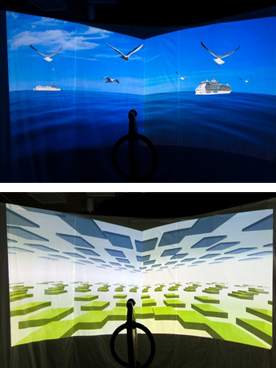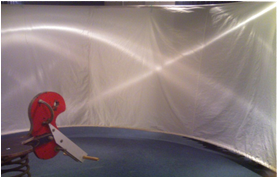Stabilight
Providing relief to ferry travelers from motion sickness using light
User centered design of visual input to relieve ferry travelers from motion sickness using light. An experiment was designed in order to determine the requirements to design an artificial horizon to prevent seasickness inside a ship cabin.
Result

Based on the scientific evidence found, using dynamic lighting to reduce motion sickness in closed environments is possible. Therefore, an exploration of human attitudes towards motion sickness was conducted. The main results were the following:
- Viewing a projected sea vista or looking outside through a window may have negative effects due to the apparent realization that one is at sea and susceptible to seasickness. This finding is contradictory to scientific evidence and therefore surprising. It illustrates the value one should give to experiential measures for a (partially) subjective experience such as motion sickness.
- When people do get sick the cabins are seen as part of the solution by ferry employees and not, as assumed, part of the problem. It is therefore suggested to reconsider the focus from cabins to public spaces on-board where people actually spend most of their time.
- We suggest that a field test is performed to assess the true merit of the Stabilight concept in an appropriate context. A gap in the current knowledge is how ferry passengers actually experience the trip and how they value the impact of motion sickness. We recommend that this important knowledge is taken into account during future projects to cross-validate our findings.
- A separate requirements document laying out the necessities for future designs.
The main requirements for stabilight applications are the following:
- Functional requirements:
- Sensing the six degrees of freedom of ship movements
- Real-time translation of the sensed movement into the represented one
- Representation of the artificial horizon
- Movement-image consistency
- Inherent illusion of motion matching
- Ability to obtain attention
- Variety of images
- Interaction with the horizon
- Social aspect
- Non functional requirements:
- Low image detail
- Image Size: 30º of the center of the visual field
- Luminance Intensity
- Pop-ups availability
- Real vs. abstract consistency
- Relevance of the image
- Pattern avoidance
- Preference for color
- Consistency across the visual field
- Claustrophobia avoidance
- Bluish color
- Focus points at distant points
- Size of projection

Method
Several research methodologies have been employed:
- Literature study and expert interview to review the scientific state of the art.
- Focus group interview with people to reveal personal experiences and implications of motion sickness for those who are sensitive to motion sickness.
- Experiment using a simple, low-cost motion simulator to gather qualitative feedback on a mid-fi prototype projected on a self-made circular immersive environment.
- Interviews at two ferry companies to integrate their experiences and perspectives.

To know more
| Technical Report | Report |
| Requirements | Requirement definition document |